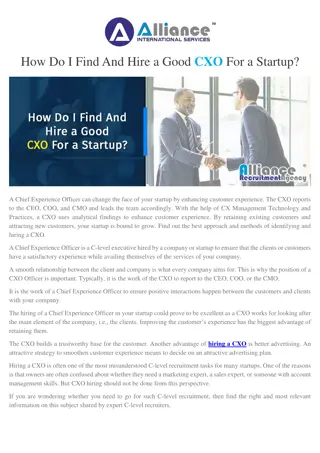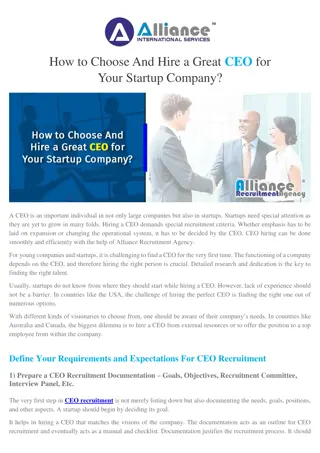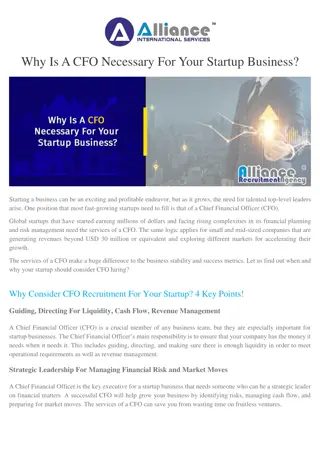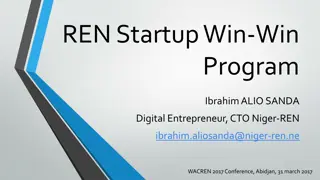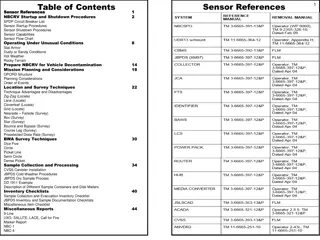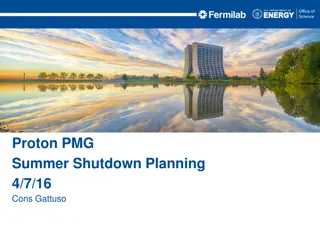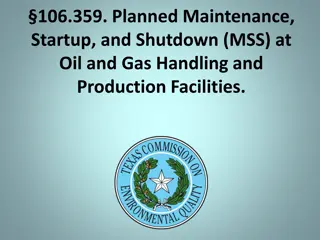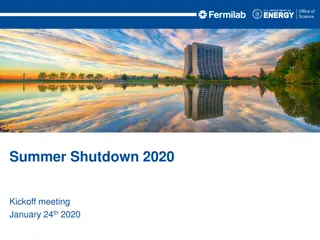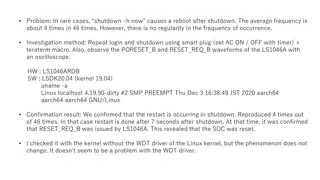Chemical Plant Startup and Shutdown Procedures
Chemical plants have critical startup and shutdown procedures to ensure safety and efficiency. Startup involves careful planning for the initial run, while shutdown involves emergency and planned procedures to safely stop operations. Various aspects such as leak prevention, valve design, gas storage, and equipment warm-up are crucial for a successful startup sequence.
Download Presentation

Please find below an Image/Link to download the presentation.
The content on the website is provided AS IS for your information and personal use only. It may not be sold, licensed, or shared on other websites without obtaining consent from the author. Download presentation by click this link. If you encounter any issues during the download, it is possible that the publisher has removed the file from their server.
E N D
Presentation Transcript
Designing For Startup/Shutdown No Book Chapter Terry A. Ring Chemical Engineering University of Utah
Startup/Shutdown is the most dangerous time in the life of a chemical plant! Typically there is a startup recipy that is followed very carefully Shutdown Emergency Shutdown Depends upon where the problem is as to how the plant will be shut down. Much of process vessel contents are sent to vent Planned Shutdown Carefully followed procedure Most of process vessel contents are captured for sale or reuse.
Startup Plant is newly built first startup Long and involved process Identifying surprises in construction Identifying bottlenecks Plant getting ready to run again for 330 days You want this to go quickly and smoothly
Distillation Plant Startup Problem Statement HW 4 Using distillation heuristics 3 (H3 - remove greatest molar flows early in sequence) and 4 (H4 - sequence in order of decreasing relative volatilities) determine the most economical sequence in terms of the annual cost of the distillation sequence for this stream assuming a 98% overall recovery of each component with a mole percentage composition of 98%.
What Happens At Startup? tC4 S8 C3 S3 B3 S5 1.72 Mpa 17 bar S7 nC4 B2 B1 S4 S9 tC5 S6 B4 S10 nC5
Before Startup, How do you assure there are no leaks? Any Implications on design?
How do you assure there are no leaks? Did you design in the Isolation valves? Do you have a pressure gage installed? What gas are you going to use? Do you have adequate onsite storage for this gas?
Startup Sequence Add mix to B1 (initial charge) Run at infinite recycle to warm up equipment Did you design valving to run at infinite recycle? Did you add a storage tank for this mixture? Add mix to B2 Run at infinite recycle to warm up equipment Add mix to B3 Run at infinite recycle to warm up equipment Add mix to B4 Run at infinite recycle to warm up equipment Then what???
Then Once all columns are operating at infinite recycle Start Feed Set boilup ratio and reflux ratio in B1, B2, B3 and B4 one at a time Open up the connection valves so that the feed can be separated from B1 to B3 and B4. Initially product purity is not to spec. Initial materials are reprocessed Do you have a tank that can handle all this off spec materal? Would surge tanks between distillation columns be useful for these initial surging conditions?
You Just Blewup the $171.5 Million Plant!!! Air was in the columns when it was charged with a fuel Fuel was then made hot in reboiler. Fires take place inside the columns-Overheating the steel and welds and melting gaskets. How to you eliminate air from a vessel and then fill it to start up? N2? Do you have a storage tank with that much N2? Are lines in place? What Pressure? Sufficient Pressure Relief Valves are they set properly, are they the correct size? Other Options??
Refineries steam the process equipment for days before hydrocarbons are added to remove air. Implications on Design Adequate Steam Drains Adequate Size to the Steam Plant Summer vs Winter (more) Plant Steaming What happens if there is a steam over pressurization? HP Steam is 450 psig (30 bar)! Is the pressure vessel thick enough for this service? Are the vents adequate for steaming Are the PRVs correct? What happens if steam is shut off when vessel is closed or vent is plugged? What happens if the Steam Plant Breaks Down in Startup and Plant cools off?
Stream Induces Vacuum Collapse https://www.youtube.com/watch?v=vzenRoxrnm8 https://www.youtube.com/watch?v=Zz95_VvTxZM
Startup Sequence Add mix to B1 (initial charge) Run at infinite recycle to warm up equipment Did you design valving to run at infinite recycle? Did you add a storage tank for this mixture? Add mix to B2 Run at infinite recycle to warm up equipment Add mix to B3 Run at infinite recycle to warm up equipment Add mix to B4 Run at infinite recycle to warm up equipment Is this the correct order to turn on the feed flow? Should the outlet, B3 and/or B4, be opened first? So reverse order is best?
Shutdown How to do a Planned Shutdown S8 S3 B3 S5 1.72 Mpa 17 bar S7 B2 B1 S4 S9 S6 B4 S10
How To Startup this process 19 16 Q-6 12 ToFlare2 31 VSSL-101 17 1 Exothermic Rxn MIX-101 16 25 32 26 REAC-103 XCHG-103 13 40 VSSL-103 26 21 50 14 DTWR-101 Q-7 K-101 15 11 22 20 XCHG-101 RCYL-2 PUMP-101 Q-4 Q-8
Startup Start Reactant Flow after steaming or inerting No recycle Make sure the control system is set up correctly to handle no recycle Rxn rate is temp dependent hot is faster reaction. Cold reactants will not react!! How do I get the reactants hot enough to react???
Startup Start Reactant Flow after steaming or inerting No recycle How do I get the reactants hot enough to react??? Need Fired heater on 26 to do the HX of the heat exchanger size is large This can be a trim heater when the process is running at steady state but it may be too big so two in parallel might be needed.
Startup How is Flash Vessel Designed?
Flash Tank Design Heat Exchange Possibilities 1) Cooling Heat Exchange Before Inlet 2) Pump around loop with cooling heat exchange in loop and cold shower in tank. 3) Heat exchange inside vessel No Heat Exchange
Startup How is Flash Vessel Designed? HX on outlet Steam or inert the vessel, Start cooling utility to HX External HX with flow loop and spray in Flash Vessel Steam or inert the vessel, Charge the flow loop, start cooling Utility, start flow in loop
Distillation Startup 19 16 Q-6 12 ToFlare2 31 VSSL-101 17 1 MIX-101 16 25 32 26 REAC-103 XCHG-103 13 40 VSSL-103 26 21 50 14 DTWR-101 Q-7 K-101 15 11 22 20 XCHG-101 RCYL-2 PUMP-101 Q-4 Q-8
19 16 Q-6 Startup 12 ToFlare2 31 VSSL-101 17 1 MIX-101 16 25 32 26 REAC-103 XCHG-103 13 40 Distillation Steam or inert the vessel, Charge column, Reboiler and Condenser Utilities turned on, Infinite Recycle to SS, then jump to finite reflux and given boilup ratio, This creates the product and recycle Let recycle continue to flow until steady state is achieved. Note Controller at mix point needs to be done to allow for startup Would a surge tank on distillation feed be useful for startup? What Startup Order Distillation first then flash, then reactor? Reactor first then flash then distillation? VSSL-103 26 21 50 14 DTWR-101 Q-7 K-101 15 11 22 20 XCHG-101 RCYL-2 PUMP-101 Q-4 Q-8
19 16 Q-6 Planned shut down 12 ToFlare2 31 VSSL-101 17 1 Exothermic Rxn MIX-101 16 25 32 26 REAC-103 XCHG-103 13 40 VSSL-103 What should we do? 1- 2- 3- 4- 26 21 50 14 DTWR-101 Q-7 K-101 15 11 22 20 XCHG-101 RCYL-2 PUMP-101 Q-4 Q-8
Design Implications Startup Heater/Trim heater Steam vents or Inerting piping and gas storage Isolation valves Surge tank before distillation Other tanks for storage of initial charges


